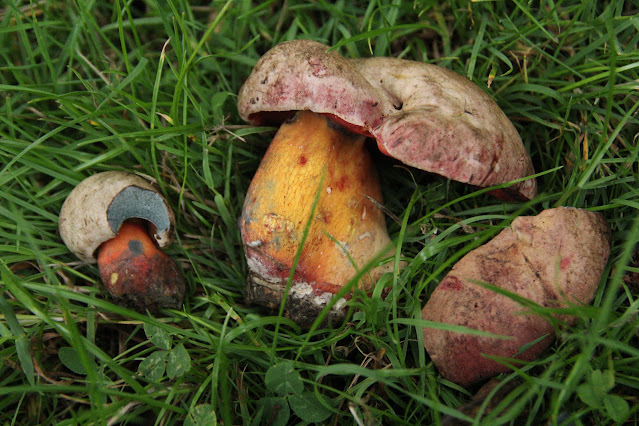Rare and interesting mushrooms in the UK
Summer came, exams have ended, and, in late summer, when the heat had subsided a little, rain engulfed the UK. I was in Spain when this happened after enduring the hottest June I can remember in the country. This pleasant weather resulted in many mushrooms and many surprises when we returned to the UK for a month. Some of the ones I found are nationally rare and important species which have been very seldom recorded in the UK. One or two are probably critically rare.
In late July, when walking around in my favourite patch of woodland near Thetford, England, I found a mushroom which is classified as Endangered in the UK. It was a tiny button, growing on a small mossy patch in the forest. It is the yellow bolete, Neoboletus pseudosulphureus.
One thing I understood very quickly about this species is that it isn't very well known. Indeed, only one UK fungi guide covers it due to its extreme rarity, and this one isn't exactly useful for collectors looking for something edible- it is a professional mycological guide. According to estimates, there are only 130 or so of these fruiting in the UK in good years, and most of them are in the far south, in ancient woodlands with oak. To find one this far north, especially in a commercial plantation, was absolutely remarkable. I don't know who was more surprised- me or the Norfolk County Recorder, who reviewed and accepted my record. I'll be interested to see if it appears there in subsequent years!
Thetford Forest may be good, but my favourite area to see fungi has long been Windsor Great Park, due to the abundance of nationally rare species there. Last year, I found an extremely unusual yellow-pored morph of the all-too familiar Rubroboletus legaliae there, a poisonous, nasty bolete which in my opinion can easily result in a couple of unhappy hours if found by someone new to the species. I found it this year as well, far more photogenic, if normal, boletes growing right by the side of a road. Rubroboletus legaliae is typically a very rare species in the UK, assessed as Vulnerable, but this year, they seem to have completely exploded due to the warm and damp summer.
Other boletes I found that day included an enormous butter bolete, as well as an interesting scarletina-type bolete in the Deer Park area. It was very vividly coloured, more colourful than anything I have seen of that species, and visually looked absolutely stunning.
However, the real surprise came when I cut it open to see the blueing response. The cap bruised normally. But the stem bruised extremely slowly, and stopped blueing soon afterwards, remaining a very light blue through which the golden flesh was clearly visible. And the base of the stem did not turn blue at all, remaining golden. It turned out that this is one example of what was once known as Boletus immutatus- a strange form of N. luridiformis which occurs exclusively at Windsor Great Park and nowhere else, Europe included. It is not the 'complete' immutatus, which completely fails to turn blue, but it is close, and such a bolete is extremely unusual.
A trip to Kersey Tye to look for orchids in early August produced unexpected encounteres with further rare boletes. White-capped rooting boletes were abundant, some with impressive-sized caps, and these were joined by a huge amount of very rare red-capped Rubroboletus legaliae mushrooms!
These ones had caps entirely flushed red, and when cut open bruised very very slowly, almost like the immutatus from Windsor. As if this wasn't enough, there were a few other boletes neabry which didn't look like it, and were ultimately identified as the deceiving bolete, Boletus queletii.
The similarity to legaliae is one reason on why it may have obtained such a disturbing name! It is also very rare, especially in our region. All of this was exceedingly surprising to see.
Recently, I was walking around in Windsor Great Park, when two pink-capped boletes, rather large ones, caught my attention. These looked unusual, and I thought, they weren't Rubroboletus legaliae, which I found twice this summer. As I touched the cap, it flushed blue. Interested, I tried to extract it from the ground, and watched with amazement as the entire orange-yellow stem turned into one ginormous blue bruise! I found the oldrose bolete, Imperator rhodopurpureus. This is an extremely rare species in the UK and endangered in the UK, and I had been looking for it for years, and never came close until this moment. This was the most beautiful bolete I have ever seen in my life.
For next year, I hope to finally see the fragrant bolete, Boletus fragrans, an extremely rare species confined to the South of England, rarer than anything I had encountered before...






.jpg)


Comments
Post a Comment